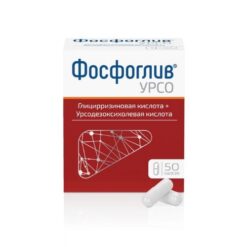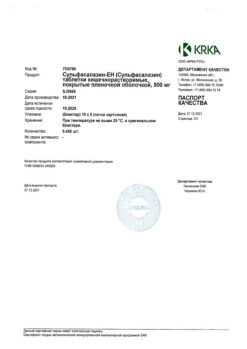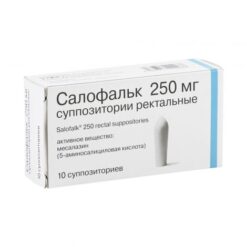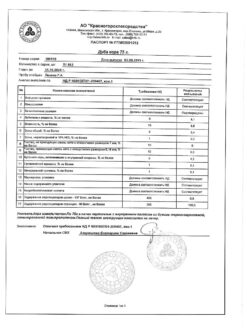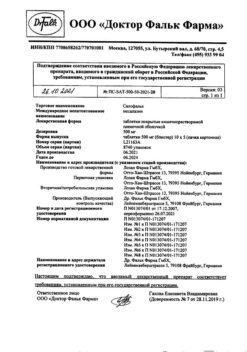No products in the cart.
Omisak, 20 mg 30 pcs.
€3.37 €3.00
EAN: 4602656001583
SKU: 212314
Categories: Medicine, Stomach, intestines, liver, Ulcer and gastritis
Description Pharmacotherapeutic group: Gastric secretion reducing agent – proton pump inhibitor Pharmacodynamics: Pharmacokinetics:
ATX: A.02.B.C.01 Omeprazole
A specific proton pump inhibitor: Inhibits H+ K+ ATPase activity in gastric parietal cells, blocking the final stage of hydrochloric acid secretion, thereby reducing acid production.
Omeprazole is a prodrug and is activated in the acidic environment of the secretory tubules of the parietal cells of the stomach.
The effects are dose-dependent and provide effective inhibition of basal and stimulated acid secretion, regardless of the nature of the stimulus. The antisecretory effect after taking 20 mg occurs within the first hour, maximum in 2 hours. Inhibition of 50% of the maximum secretion lasts for 24 hours. Single daily intake provides rapid and effective inhibition of gastric secretion during the day and night, which reaches its maximum after 4 days of treatment and disappears by the end of 3-4 days after the end of intake. In patients with duodenal ulcer disease, administration of 20 mg of omeprazole maintains intragastric pH above 3 for 17 hours.
Absorption is high, time to reach maximum concentration (Tmax) is 0.5-3.5 h, bioavailability is 30-40% (increases to almost 100% in liver failure); having high lipophilicity, easily penetrates into the parietal cells of the stomach, binding to plasma proteins is 90-95% (albumin and acidic alpha1-glycoprotein). The elimination half-life (T1/2) is about 0.5-1 h (in hepatic insufficiency – 3 h), total plasma clearance is 500-600 ml/min. It is almost completely metabolized in the liver with participation of cytochrome P450 (CYP) enzyme system with formation of six pharmacologically inactive metabolites (hydroxyomeprazole, sulfide and sulfone derivatives, etc.). It is an inhibitor of CYP2C19 isoenzyme. Excretion by the kidneys (70-80%) and with bile (20-30%). In chronic hepatic insufficiency, excretion decreases in proportion to the decrease in creatinine clearance. In elderly patients excretion decreases, bioavailability increases.
.
Indications
Indications
Peptic ulcer disease of the stomach and duodenum (including.
Peptic ulcer disease (including prevention of recurrence),
Reflux esophagitis,
Hypersecretory conditions (Zollinger-Ellison syndrome, stress ulcers of the GI tract, polyendocrine adenomatosis, systemic mastocytosis),
/p>
NSAID gastropathy,
Eradication of Helicobacter pylori in infected patients with peptic ulcer disease of the stomach and duodenum (as part of combination therapy).
Active ingredient
Active ingredient
Composition
Composition
Each capsule is enteric-soluble and contains:
The active ingredient: omeprazole (in the form of enteric-coated pellets) 20 mg.
Auxiliary ingredients in omeprazole pellets: mannitol, sucrose, sodium hydrophosphate, sodium lauryl sulfate, lactose monohydrate, calcium carbonate, hypromellose (E-15), propylene glycol, methacrylic acid and ethyl acrylate copolymer [1:1], polysorbate-80, diethyl phthalate, sodium hydroxide, cetyl alcohol, corn starch.
The composition of the empty hard gelatin capsule: cap: gelatin, purified water, methyl parahydroxybenzoate, propyl parahydroxybenzoate, brilliant blue dye, iron oxide yellow dye, titanium dioxide, azorubin dye; body: gelatin, purified water, methyl parahydroxybenzoate, propyl parahydroxybenzoate, titanium dioxide.
The composition of the ink for marking the capsule shell: black ink: shellac, dehydrated alcohol, isopropanol, butanol, propylene glycol, black iron oxide dye (E 172), purified water; white ink: shellac, dehydrated alcohol, isopropanol, butanol, propylene glycol, titanium dioxide (E 171), polysorbate 80.
How to take, the dosage
How to take, the dosage
Overly with a small amount of water (the contents of the capsule must not be chewed) before meals.
Penal ulcer in the acute phase – 20 mg per day for 2-4 weeks (in resistant cases up to 40 mg per day).
Peptic ulcer disease in the phase of exacerbation and erosive-ulcerous esophagitis – 20-40 mg per day for 4-8 weeks.
Errotic ulcerative lesions of the gastrointestinal tract caused with taking NSAIDs – 20 mg per day for 4-8 weeks.
Eradication of Helicobacter pylori – 20 mg 2 times per day for 7 or 14 days (depending on the regimen used) in combination with antibacterial agents.
For prevention of recurrence of peptic ulcer disease of the stomach and duodenum – 20 mg per day.
For the prevention of recurrence of reflux esophagitis – 20 mg per day for a long time (up to 6 months). Administration on demand (symptomatic treatment).
Zollinger-Ellison syndrome – the dose is adjusted individually depending on the initial level of gastric secretion, usually starting at 60 mg per day. If necessary, the dose is increased to 80-120 mg per day, in which case it is divided into 2 doses.
In patients with severe hepatic insufficiency, the daily dose should not exceed 20 mg.
Interaction
Interaction
Special Instructions
Special Instructions
Before starting therapy, the presence of a malignant process (especially with gastric ulcers) should be ruled out, since treatment, by masking symptoms, can delay the correct diagnosis.
Taking at the same time with food does not affect its effectiveness.
In special cases if it is difficult to swallow the whole capsule, the contents may be swallowed after opening or disgorging the capsule, or the capsule contents may be mixed with a slightly acidified liquid (juice, yogurt) and the resulting suspension may be used within 30 minutes.
Contraindications
Contraindications
Hypersensitivity to the drug, childhood, lactation.
Hepatic and/or renal insufficiency.
Side effects
Side effects
In rare cases, the following usually reversible adverse reactions may occur. The frequency of adverse effects is classified according to the incidence of the case: very frequently over 1/10, frequently over 1/100 and less than 1/10, infrequently over 1/1000 and less than 1/100, rarely over 1/10000 and less than 1/1000, very rarely less than 1/10000, including isolated cases. Within each frequency class, adverse effects are presented in decreasing order of severity.
Blood and lymphatic system disorders: rare – leukopenia, thrombocytopenia; very rare – agranulocytosis, pancytopenia.
Allergic reactions: rare – hypersensitivity reactions, including fever, angioedema and anaphylactic reactions (including anaphylactic shock).
Metabolism and nutrition: rarely – hyponatremia, very rarely – hypomagnesemia.
Mental disorders: infrequent – insomnia, rarely – agitation; confusion, depression; very rare – aggression, hallucinations.
Nervous system disorders: often – headache; infrequent – dizziness, paresthesia, somnolence; rarely – taste disorders.
An organ of vision: rarely – blurred vision.
Hearing and balance disorders: infrequent – vertigo.
Gastrointestinal tract: frequently – diarrhea or constipation, nausea, vomiting, flatulence, abdominal pain; rarely – dry mouth, stomatitis, candidiasis of the mucous membrane of the gastrointestinal tract,
Hepatic and biliary tract disorders: infrequent – increased activity of “liver” enzymes; rare – in patients with previous severe liver disease – hepatitis (including with jaundice), very rare – liver failure, including.including with the development of encephalopathy (in patients with liver disease in anamnesis).
Skin disorders: infrequent dermatitis, pruritus, rash, urticaria, rarely alopecia, photosensitization; very rarely erythema multiforme, Stevens-Johnson syndrome, toxic epidermal necrolysis.
Musculoskeletal system: rare – arthralgia, myalgia; very rare – muscle weakness.
Allergic reactions: urticaria, angioneurotic edema, bronchospasm, interstitial nephritis, anaphylactic shock, fever.
Urogenital system disorders: rarely – interstitial nephritis.
Gender and mammary system disorders: very rare – gynecomastia.
Others: infrequent – malaise, peripheral edema; rarely – bronchospasm, increased sweating.
Overdose
Overdose
Pregnancy use
Pregnancy use
The use of omeprazole during pregnancy is possible only if the expected therapeutic benefit exceeds the potential risk to the fetus.
In lactation, it is necessary to decide whether to stop breastfeeding or to discontinue the drug.
Similarities
Similarities
Additional information
| Weight | 0.028 kg |
|---|---|
| Shelf life | 2 years. Do not use after the expiration date printed on the package. |
| Conditions of storage | Store at a temperature not exceeding 25 °C. Store out of the reach of children! |
| Manufacturer | Torrent Pharmaceuticals Ltd, India |
| Medication form | enteric capsules |
| Brand | Torrent Pharmaceuticals Ltd |
Related products
Buy Omisak, 20 mg 30 pcs. with delivery to USA, UK, Europe and over 120 other countries.


